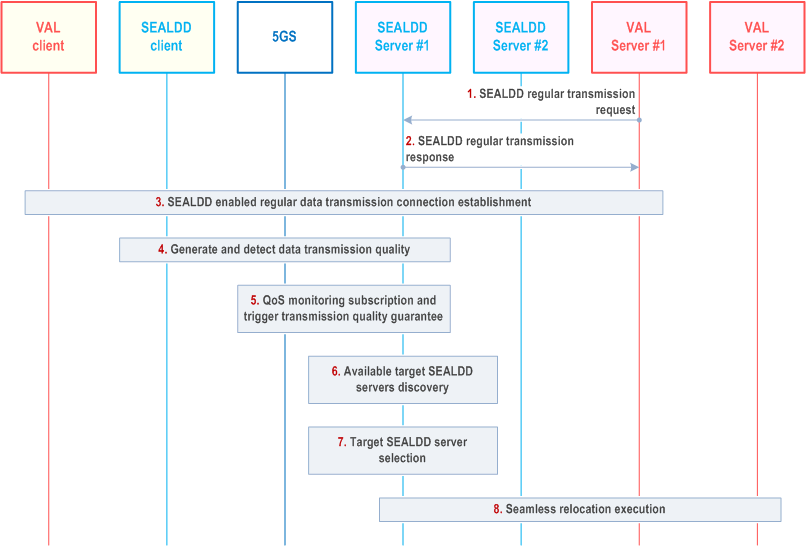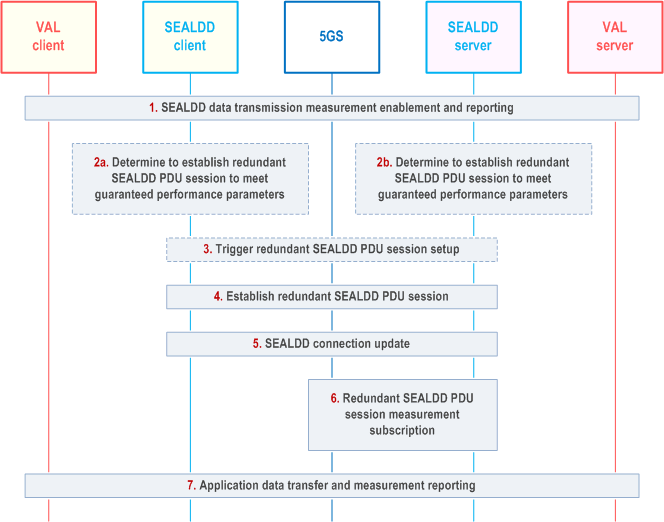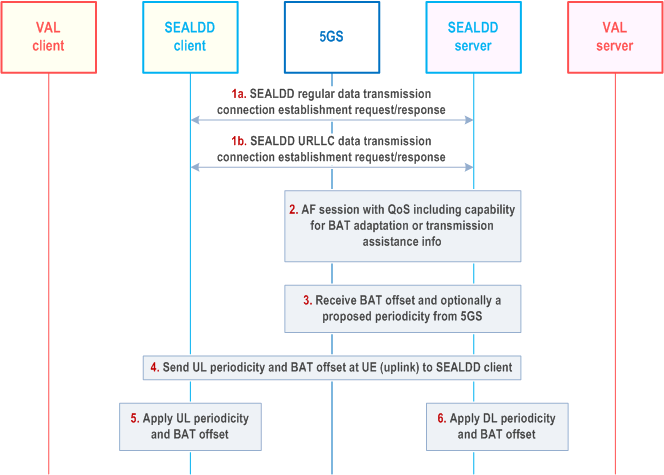Content for TS 23.433 Word version: 19.0.0
0…
4…
7…
8…
9.2…
9.2.2.3…
9.2.3…
9.2.4…
9.3…
9.3.2.2…
9.3.3…
9.3.4…
9.4…
9.5…
9.5.3…
9.5.4…
9.6…
9.7…
9.7.3…
9.7.4…
9.8…
9.9…
9.10…
A…
C…
9.9 SEALDD enabled data transmission quality guarantee
9.9.1 General
9.9.2 Procedures
9.9.2.1 SEALDD enabled data transmission quality guarantee by switching SEALDD server
9.9.2.2 SEALDD enabled data transmission quality guarantee with redundant transport
9.9.2.3 SEALDD enabled data transmission quality guarantee with BAT and periodicity adaptation
9.9.3 Information flows
9.9.3.1 Transmission quality management request
9.9.3.2 Transmission quality management response
9.9.4 APIs
9.9.4.1 General
9.9.4.2 Sdd_TransmissionQualityManagement Request operation
...
...
9.9 SEALDD enabled data transmission quality guarantee p. 77
9.9.1 General p. 77
The following clauses specify procedures, information flows and APIs for SEALDD enabled data transmission quality guarantee.
9.9.2 Procedures p. 77
9.9.2.1 SEALDD enabled data transmission quality guarantee by switching SEALDD server p. 77
Figure 9.9.2.1-1 illustrate the procedure for data transmission quality guarantee based on transmission quality report from SEALDD server and QoS monitoring from 5GS. The procedure is applicable to the scenario where there is a single path between UE and SEALDD server.
Pre-conditions:
- The VAL server discovers and selects the SEALDD server by CAPIF functions.
-
The VAL server has requested the transmission quality measurement to the SEALDD server by invoking the Sdd_
TransmissionQualityMeasurement_ API in clause 9.7.4.2.subscription - A SEALDD service policy (i.e., the necessary SEALDD layer actions for meeting the service policy requirements) has been configured in SEALDD server and shared with the SEALDD client.

Step 1.
The VAL server sends a Sdd_RegularTransmission request to the SEALDD server, as specified in clause 9.2.2.2. The request includes the identifiers of the application traffic (e.g. VAL service ID, VAL server ID), and optionally, the QoS information for the application traffic, e.g. QoS requirements.
Step 2.
Upon receiving the request, the SEALDD server performs an authorization check. If authorization is successful, the SEALDD server sends a response to the VAL server. The QoS information may be allocated by SEALDD server according to VAL service ID for different service type of application traffic if the QoS information is not provided by VAL server.
Step 3.
The regular data transmission connection is established according to clause 9.2.2.2.
Step 4.
The S-SEALDD server (i.e., SEALDD server#1) can generate the transmission quality measurement report according to the SEALDD enabled transmission quality measurement procedure in clause 9.7.2.1, and detect whether the current transmission quality can satisfy the QoS requirements of VAL application.
Step 5.
The S-SEALDD server subscribes to 5GC for QoS monitoring of the specific UE related to the VAL user, as defined in clause 5.2.6.9 of TS 23.502. If the S-SEALDD server diagnoses that QoS deterioration is caused by N6/SEALDD overload (i.e., based on QoS monitoring between UE and UPF, and the E2E transmission quality measurement). The S-SEALDD server can determine to trigger the data transmission quality guarantee procedure (i.e., switching the connected SEALDD server according to SEALDD service policy) based on the QoS monitoring and E2E transmission quality measurement.
Step 6.
The S-SEALDD server performs target SEALDD server discovery procedure by using EEL, as specified in clause 9.4.
Step 7.
The S-SEALDD server can select the T-SEALDD server (i.e., SEALDD server #2) based on N6 traffic and/or SEALDD server load from performance of the available target SEALDD servers in step 6.
Step 8.
The SEALDD relocation procedure is performed for the switched SEALDD servers and the switched VAL servers, as specified in clause 9.6.2.2.
After the SEALDD relocation procedure, the SEALDD client can connect to the selected T-SEALDD server to obtain the data transmission quality guarantee service (i.e. the QoS requirements of VAL application can be satisfied).
9.9.2.2 SEALDD enabled data transmission quality guarantee with redundant transport p. 79
Figure 9.9.2.2-1 illustrates the procedure of using redundant transmission as the action to meet connection reliability requirements specified by a SEALDD service policy.
Pre-conditions:
- A SEALDD service policy, which includes data transmission quality guarantees, is available to SEALDD server. The policy can be used to configure measurements and determine the necessary SEALDD layer actions for meeting the service policy requirements.
- The SEALDD Client is authorized to request redundant transport services on behalf of the VAL client.

Step 1.
When the SEALDD measurement results indicating that the SEALDD data transmission has good performance according to policy guarantee threshold, if the measurement was started by the SEALDD client, the SEALDD client may release one transmission path and return back to single SEALDD connection mode, otherwise the SEALDD server may send a Transmission quality management request to the SEALDD client requesting to use single transmission, then the SEALDD client releases one transmission path and returns to single SEALDD connection mode.
A VAL client and server establish a SEALDD connection to transport the application data. As part of the connection establishment, the SEALDD service policy in precondition 1 is shared so that it is available to both the SEALDD client and the SEALDD Server. The SEALDD Server may use the data transmission quality requirements of this policy in conjunction with other local policies pre-provisioned at the SEALDD server. The SEALDD server determines whether to start data transmission quality measurement by itself or by the SEALDD client. As a result, SEALDD measurements (e.g. packet loss rate, latency) are configured either at the SEALDD client as described in clause 9.7.2.3 or at the SEALDD server as described in clause 9.7.2.1 and started accordingly. Then either the SEALDD client or server receives measurement reports.
Step 2.
Based on measurement reports and the SEALDD service policy, depending on the which entity started the measurement, either the SEALDD client or server determines to perform an action so that the data transmission quality requirements of the policy are met.
Step 3.
Specifically, if the measurement was started by the SEALDD client, the SEALDD client triggers the establishment of redundant transmission services. If the measurement was started by the SEALDD server, the SEALDD server triggers the establishment of redundant transmission services by sending a Transmission quality management request to the SEALDD client requesting to establish redundant transmission path.
Step 4.
The SEALDD client uses steps 6 to 9 of the procedure in clause 9.3.2.1 to request the use of redundant transmission service from the SEALDD server. As part of this step, the UE may end the initial PDU session and establish redundant PDU sessions.
Step 5.
The SEALDD client updates the SEALDD connection with the redundant transmission information, i.e., the UE addresses and ports for the redundant PDU sessions, the SEALDD flow identifier, and the application traffic descriptors. The SEALDD client or server also configures the parameters for enabling any necessary SEALDD measurements for the new SEALDD flow.
Step 6.
The SEALDD server may subscribe to receive notifications from the 5G network for user plane measurements (e.g., the network latency requirements specified in TS 28.541), network analytics (as specified in TS 28.104, etc.).
Step 7.
The SEALDD client and server handle data duplication and elimination of application traffic on the redundant SEALDD flows and the necessary measurements are collected by the SEALDD client or server.
9.9.2.3 SEALDD enabled data transmission quality guarantee with BAT and periodicity adaptation |R19| p. 80
Figure 9.9.2.3-1 illustrates the procedure of using 3GPP CN (5GS) capability for BAT and periodicity report and application layer adjustment in SEALDD layer for data transmission.
Precondition:
- SEALDD layer connection needs to be established as described in clause 9.2 and clause 9.3.
- In policy driven SEALDD connection management, the VAL server has indicated quality optimization policy during SEALDD policy configuration procedure as described in clause 9.10.

Step 1.
A VAL client and server establish a SEALDD regular or redundant connection to transport the application data as described in clause 9.2 or clause 9.3. The connection establishment may be triggered by either SEALDD server or SEALDD client. During the connection establishment, the SEALDD client includes an indication for data transmission adjustment request as part of the connection establishment over SEALDD-UU reference point.
In SEALDD-UU connection establishment, the SEALDD client also includes its capability for BAT and periodicity adaptation, or transmission assistance info to the SEALDD server in the connection establishment request (SEALDD client triggered establishment) or response (SEALDD server triggered establishment).
Step 2.
The SEALDD server, based on received data transmission adjustment request from VAL server or SEALDD client, its own capability and/or received capability from SEALDD client for BAT and periodicity adaptation, and its own DL transmission assistance info and/or received transmission assistance info from SEALDD client, subscribes to 5GS AF session with QoS service with capability for BAT adaptation or transmission assistance info as described in clause 4.15.6.6 and 4.16.6.4 of TS 23.502.
Step 3.
The SEALDD server receives BAT offset and optionally a proposed periodicity (which was adjusted in 5GS) in AF session with QoS notification from 5GS.
Step 4.
If the SEALDD client indicated its BAT and periodicity adaptation capability in step 1 during SEALDD connection establishment, the SEALDD server sends UL periodicity and BAT window to the SEALDD client in Transmission quality management request with transmission parameter adjustment action.
Step 5.
The SEALDD client applies UL periodicity and BAT offset for uplink SEALDD data.
Step 6.
The SEALDD server locally applies DL periodicity and BAT offset for downlink SEALDD data.
9.9.3 Information flows p. 81
9.9.3.1 Transmission quality management request p. 81
Table 9.9.3.1-1 describes the information flow from the SEALDD server to the SEALDD client for requesting data transmission quality management.
| Information element | Status | Description |
|---|---|---|
| SEALDD flow ID | M | Identifier of the SEALDD flow. |
| Transmission quality management action | M | Indicates the data transmission quality guarantee action (e.g. redundant transmission path, re-establish transmission path, switch to backup transmission path) or optimization action (back to single transmission path, transmission parameter adjustment) that triggering by event (e.g. measurement threshold). |
| UL periodicity (NOTE) | O | Uplink periodicity. |
| BAT offset for UL (NOTE) | O | BAT offset for Uplink data. |
|
NOTE:
The IE is applicable for transmission parameter adjustment.
|
||
9.9.3.2 Transmission quality management response p. 81
Table 9.9.3.2-1 describes the information flow from the SEALDD client to the SEALDD server for responding to the transmission quality management request.
| Information element | Status | Description |
|---|---|---|
| Result | M | Success or failure. |
9.9.4 APIs p. 82
9.9.4.1 General p. 82
Table 9.9.4.1-1 illustrates the APIs exposed by SEALDD client for data transmission quality management.
| API Name | API Operations | Operation Semantics | Consumer(s) |
|---|---|---|---|
| Sdd_ | Request | Request/Response | SEALDD server |
9.9.4.2 Sdd_TransmissionQualityManagement Request operation p. 82
API operation name:
Sdd_TransmissionQualityManagement Request
Description:
The consumer requests for one time for transmission quality management.
Inputs:
See clause 9.9.3.1.
Outputs:
See clause 9.9.3.2
See clause 9.9.2.2 for details of usage of this operation.